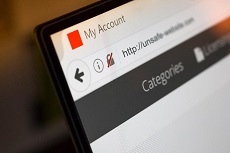
Undoubtedly, you know a few ways that malware makes its way onto victims’ systems: infected USB drives, corrupt email links, dangerous attachments and others. Businesses must stay in-the-know regarding malware transmission to educate their workforce and avoid viruses that could result in costly and damaging data breaches. Yet, while you focus on keeping your devices and networks safe from infection, you might be overlooking a serious source of potential pain: your website.
These days, a business cannot succeed without a website — but your website could be the weakest element of your security strategy. If you aren’t focusing on keeping your website safe, it could be your undoing. Here’s how.
How Websites Spread Malware
The reason you know so much about other vectors of malware — USB drives, email links and attachments, etc. — is that these malware methods were long the most popular ways to spread a virus far and wide. Decades ago, when malware was young, a malware creator wanted nothing more or less than to prove that they were the most destructive hacker on the Web, and corrupt drives and emails were the best way to increase a virus’s scope.
Fortunately, the public caught on to these transmission methods, and most have girded themselves effectively with smart cyber hygiene and smarter security software. Unfortunately, hackers have altered their tactics — and their goals. Today, most cybercriminals are after money, not notoriety, and because the old-fashioned techniques are so well-known and well-anticipated, most have turned to newer and more profitable methods: infecting websites.
There are three ways that hackers can distribute malware through websites:
- They create their own corrupt websites. This is more common than you might expect. All a hacker needs to do is build a website — which is mercifully cheap and easy thanks to tools like Wix and Squarespace — and lace it with dangerous malware.
- They exploit a vulnerability on a Web server. Web servers are plagued by vulnerabilities through which hackers can install malicious banner ads, downloads and more. For example, there are many well-known vulnerabilities in Microsoft Internet Information Services servers, including problems with default installation, session management and more.
- They exploit a vulnerability in website applications. Long ago, websites were little more than static text and images — but today, a website is filled with complex code, producing rich, dynamic user experiences. Unfortunately, the more that this occurs on a website, the more opportunities hackers have to gain access.
Once a hacker has found a way onto a website, they can infect banner ads, links, downloads and more with malware that will plague each and every visitor. Eventually, your customers will stop visiting your website for fear of infection, and your business will severely suffer.
How to Secure Your Business Site
Even if your website is susceptible to attack now, it doesn’t have to stay that way. There are plenty of methods for securing your website against attack, and protecting your customers and your business from the greedy clutches of cybercriminals.
Perhaps the easiest way to maintain the safety of your website is to utilize a wesite security tool. Just as you have security software protecting your network and endpoints, there is security software to watch over your website. Tools like SiteLock scan websites for malware and application-based vulnerabilities and work to keep hackers at bay. You can read SiteLock reviews to better understand how its features help businesses like yours stay safe online.
However, if you enjoy DIY security solutions, you can eschew the simple option for your own bespoke protection. First, you should test your website for weaknesses, looking specifically for some well-known vulnerabilities, such as:
- Cross-site scripting (XSS)
- URL redirects
- Cookie manipulation
- Code execution
- Cross-site request forgery injections (CSRF)
- Structured query language injections (SQLi)
Then, you should work to limit server-based vulnerabilities as much as possible. For example, if you use Apache, you should strongly consider disabling the Apache banner, disabling directory indexing, disabling WebDAV and turning off the TRACE HTTP request. However, because servers update often, you will likely need to stay up-to-date on the latest vulnerabilities and methods for keeping them closed tight on your site.
Your website is a necessary tool for attracting customers and making sales, but that tool could also be your downfall if you don’t keep it safe from attack. As long as you understand the dangers and take steps to reduce them as much as possible, you should benefit from your website — not suffer from it.






